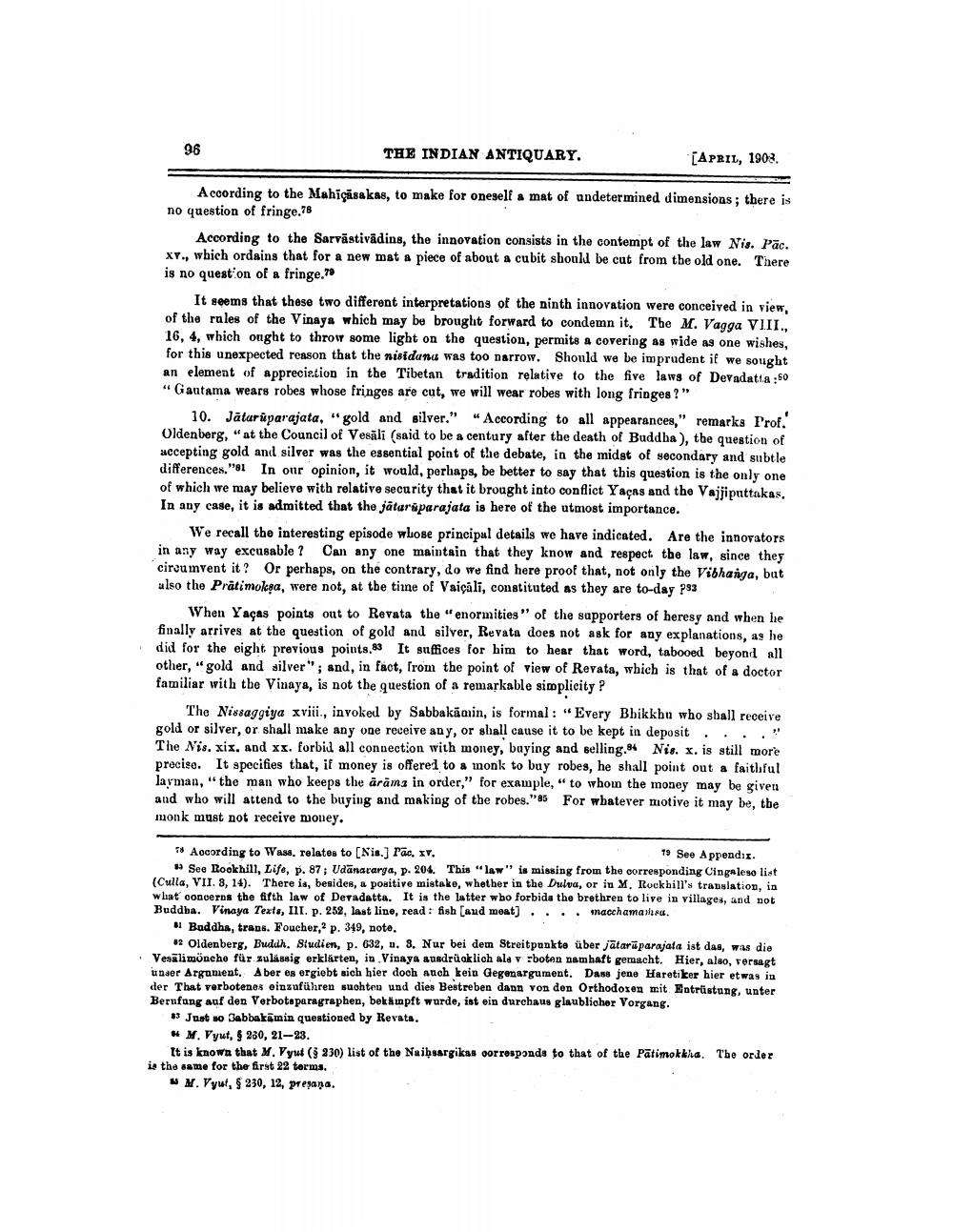________________
96
THE INDIAN ANTIQUARY.
[APRIL, 1903.
According to the Mahigisakas, to make for oneself a mat of andetermined dimensions; there is no question of fringe.78
According to the Sarvästivādins, the innovation consists in the contempt of the law Nis. Pāc. XY., which ordains that for a new mat a piece of about a cubit should be cut from the old one. There is no question of a fringe.70
It seems that these two different interpretations of the ninth innovation were conceived in view, of the rules of the Vinaya which may be brought forward to condemn it. The M. Vagga VIII., 16, 4, which onght to throw some light on the question, permits a covering as wide as one wishes, for this unexpected reason that the nisidunu was too narrow. Should we be imprudent if we sought an element of appreciation in the Tibetan tradition relative to the five laws of Devadatta :50 "Gautama wears robes whose fringes are cut, we will wear robes with long fringes?"
10. Jaturûparajata, "gold and silver." "According to all appearances," remarks Prof. Oldenberg, "at the Council of Vesāli (said to be a century after the death of Buddha), the question of accepting gold and silver was the essential point of the debate, in the midst of secondary and subtle differences."sl In our opinion, it would, perhaps, be better to say that this question is the only one of which we may believe with relative security that it brought into conflict Yaças and the Vajjiputtakas. In any case, it is admitted that the játar parajata is here of the utmost importance.
We recall the interesting episode whose principal details we have indicated. Are the innovators in any way excusable? Can any one maintain that they know and respect the law, since they circumvent it? Or perhaps, on the contrary, do we find here proof that, not only the Vibhanga, bat also the Prātimokosa, were not, at the time of Vaicāli, constituted as they are to-day 233
When Yaças points out to Revata the "enormities" of the supporters of heresy and when he finally arrives at the question of gold and silver, Revata does not ask for any explanations, as he did for the eight previous points.83 It suffices for him to hear that word, tabooed beyond all other, gold and silver"; and, in fact, from the point of view of Revata, which is that of a doctor familiar with the Vinaya, is not the question of a remarkable simplicity ?
The Nissaggiya xviii, invoked by Sabbakāmin, is formal : "Every Bhikkhu who shall receive gold or silver, or shall make any one receive any, or shall cause it to be kept in deposit. .." The Nis. xix, and xx. forbid all connection with money, baying and selling. Nis. x. is still more precise. It specifies that, if money is offered to a monk to buy robes, he shall point out a faithful layman, "the man who keeps the drama in order," for example, "to whom the money may be given and who will attend to the buying and making of the robes."85 For whatever motive it may be, the monk must not receive money.
* According to Wass, relates to [Nis.] rac, Iv.
19 See Appendır. See Rookhill, Life, P. 87; Udānararga, p. 206. This "law" is missing from the corresponding Cingalese list (Culla, VII. 3, 16). There is, besides, a positive mistake, whether in the Dulya, or in M. Rockhill's trauslation, in wat oors the fifth law of Deradatta. It is the latter who forbida the brethren to live in villages, and not Buddha. Vinaya Teata, III. p. 212, last line, read : fish Caud moat).... macchamasha.
" Baddha, trans. Foucher, p. 349, note.
12 Oldenberg, Buddh. Studien, p. 632, 1. 3. Nur bei dem Streitpunkto über jätaräparajala ist das, was die Vesili münche für zulässig erklärten, in Vinaya ausdrücklich als vrboten namhaft gemacht. Hier, also, versagt unaer Argument. Aber es orgiebt sich hier doch auch kein Gegenargument. Dass jene Haretiker hier etwas in der That verbotenen oinzuführen suohten und dies Bestreben dann von den Orthodoxen mit Entrüstung, unter Berufung auf den Verbota paragraphen, bekkenpft wurde, ist ein durchaus glaublicher Vorgang.
* Just so 3abbakāmin questioned by Revata. # M. Vyut, $ 250, 21-23.
It is known that M. Vyu (230) list of the Naibsargikss corresponds to that of the Pātimokkha. be order is the same for the first 22 terms.
- M. Vyut, $ 230, 12, presaņa.




